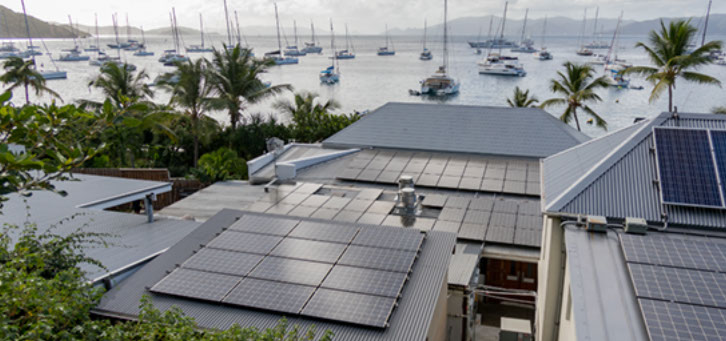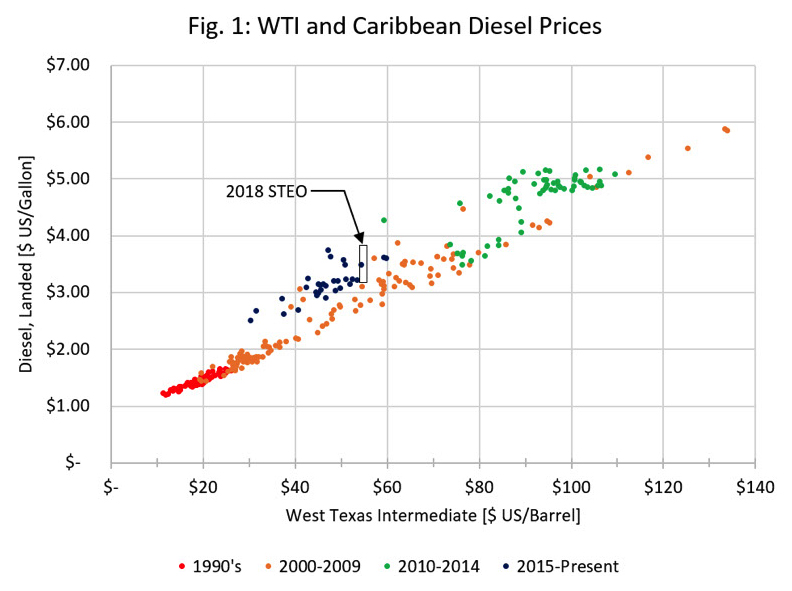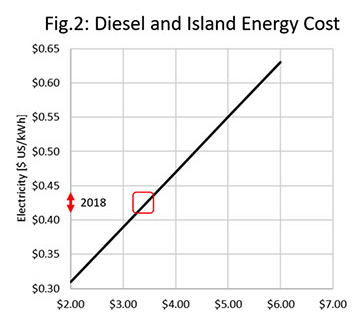
Understanding your all-in expense cost of electricity generated from burning fossil fuels is an eye-opening exercise. The indirect financial costs and environmental impacts are not quite so easy to quantify, but we will even take a look at that later on.
The first step is to understand the cost for the Number-2 diesel fuel. The cost of Diesel No.2 is surprisingly correlated to the cost of West Texas Intermediate (WTI) crude oil. Figure 1 shows these two benchmarks going back to 1994 (Source: US Energy Information Administration, EIA).
Note that the vertical variability in the 1990’s is very low. The vertical variability increases as cost increases, likely due to the increased cost of delivery. It takes fuel to deliver fuel, right?
Also shown in Figure 1 is the 2018 forecast for WTI from the EIA Short Term Energy Outlook (STEO). They’re looking for $55/barrel WTI next year, and that probably means landed diesel fuel cost is in the range of $3.25 to $3.75 per gallon, depending on where it is delivered.

The US military makes a similar comparison. They consider the cost of diesel to be the same no matter where it is used. It is always the cost at their distribution depot. But the cost of delivery can be quite high – exceeding $2,000 per gallon, according to some Navy experts, for fuel delivered to a combat locale.
A consistent performance metric is that a diesel engine-generator set (genset) will usually produce about 12.5 to 14 kWh per gallon of fuel, if they are operated in their linear performance range of roughly 40% to 100% of rated power. Other fuels vary a bit, but are all relatively close to that metric. Larger, better maintained gensets will be at the high end of that range, and we usually use 13 kWh/gallon as a real-world number. That’s also about 3.4 kWh/liter. That holds true whether it is a 75 kW or a 2 MW genset. At lower power settings, the efficiency drops off sharply.
That’s an easy calculation. When the fuel is $4.00 per gallon delivered cost, that results in a variable cost of about $0.31/kWh just for the fuel.
But if you own and operate the powerplant, your cost of electricity it is more than just the variable fuel cost. The cost of electricity is a combination of variable fuel cost, plus the variable and fixed cost of operation and maintenance of the powerplant, plus whatever is put aside for “reserves” for repairs or replacement. Adding reasonable O&M and reserves to that is another $0.15/kWh, making the total effective cost of energy about $0.46/kWh.
Manufacturers and trade groups usually have a range of O&M and reserve costs. The HOMER Energy © simulation application also has typical cost ranges. These are $0.05 to $0.15 per kWh for O&M and $0.10 to $0.20 per kWh for reserves. We have made various calculations from our US and Caribbean clients, and settled on a good average of $0.07/kWh for O&M and $0.08/kWh for reserves. Remember also that these numbers should be incremented by the rate of inflation.
Figure 2, then, shows the combination of variable fuel plus O&M and reserves. The same STEO range is shown for 2018, and then the resulting all-in electricity cost.

